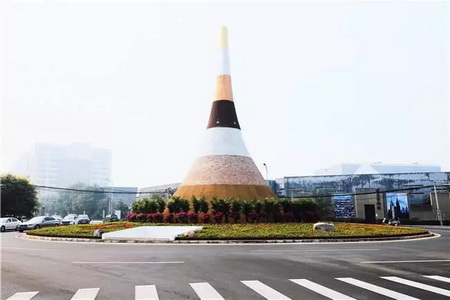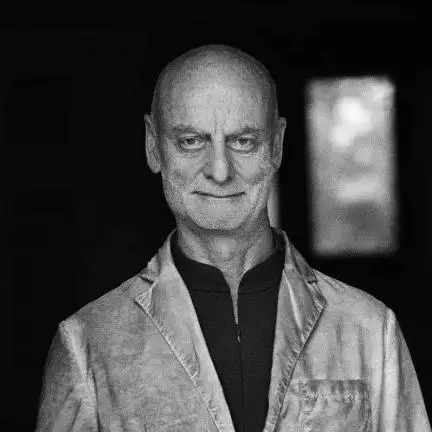
▲乌利·希克(Uli Sigg)
乌利·希克,瑞士人,1995年至1998年任瑞士驻中国大使。乌利·希克从80年代开始接触中国先锋艺术,收藏了180多位艺术家的近2000件作品。乌利·希克被称为“完整收藏了中国当代艺术的人”,英国艺术杂志《ArtReview》将他评为“影响世界艺术100人”之一。
作为中国当代艺术最具影响力的收藏家,服务器艺术也非常荣幸的邀请到了希克先生加入专家委员会。为此,服务器艺术基金会(筹)理事长谢蓉,理事会理事成卓,艺术总监顾振清、共同对乌利·希克进行了采访,希克先生也回应了他最新的收藏动向、对中国当代艺术的独到理解、“后疫情时代”的艺术发展趋势等等问题,并对服务器艺术平台的发展提出了诸多建议。
本次采访内容分为两期推送,本次是采访的下半部分。
Uli Sigg served asthe Swiss ambassador to China from1995 to 1998. He first encountered Chinese avant-garde art in the 1980s, and since that time, he has collected more than 2,000 works by over 180 artists. Uli Sigg’s collection has been recognized as the most comprehensive collection of Chinese contemporary art, and he has beennamed in the ArtReview Power 100 list, which recognizes the world’s one hundredmost influential people in art every year.
The Server Art Foundation is honored that Uli Sigg, one of the most influential collectors of Chinese contemporary art, has joined its Expert Committee. Here, Sigg is interviewed by Xie Rong, chair of the Server Art Foundation, and Joy Cheng, member of the board of directors of the Server Art Foundation,Gu Zhenqing, art director of the Server Art Foundation. In the interview, Sigg discussed his current thinking about collecting, his unique understanding of Chinese contemporary art, and the development of art in the post-pandemic world. He also offered numerous suggestions for the future development of the Server Art Foundation.
The interview will be presented in two parts. This is the second half of the intervijidian
上期回顾
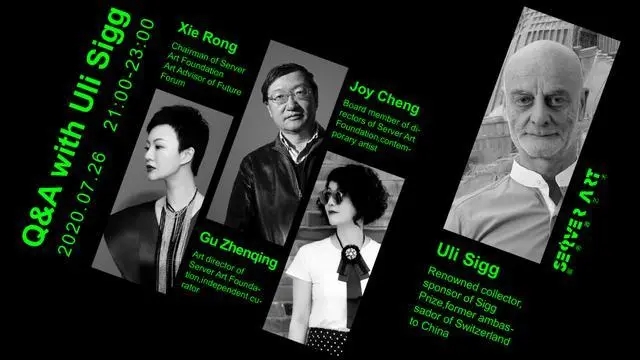
顾振清
我去年在中国策划了《物演》展览,为了这个展览,我们召集了五位艺术家和五位科学家。他们不但有深入的交谈,而且每个人都参观了对方的工作室和实验室。当他们谈论潜在的逻辑或思考时,发生了什么呢——艺术家们的很多思考途径让科学家们感到惊讶,反之亦然。目前,服务器艺术基金会(筹)正在与未来论坛、锡纯基金会和Zeng Harburg Initiative 基金会联合筹备科学艺术双年展。我们很高兴邀请您担任这次展览的名誉主席。
我们知道您每年都会参加许多大型国际展览,如威尼斯双年展、卡塞尔文献展、巴塞尔艺术展等,也非常熟悉在中国举办的双年展。通过将科学艺术双年展打造成一个新的、具有实验性的双年展,我们希望科学家和艺术家能够在同一个想法上进行合作,互相开放工作室、实验室,从而让他们培育、孵化出以共同创造性思维为基础的深入合作,而不是简单地停留在生产或技术应用的合作层面。您对科学艺术双年展有什么想法和建议吗?我们应该如何推广这种新型的双年展?能和我们分享一下您的经验吗?
Gu Zhenqing: I curated an exhibition in China last year entitled “Everything Evolution.” We brought together five artists and five scientists. They had conversations, deep conversations, and they each visited the other’s studio or lab. When they talked about their underlying logic or thinking, something happened. The artists surprised the scientists in a lot of ways, and vice versa. Currently, the Server Art Foundation is preparing for the Science and Art Biennale in association with the Future Forum, the Xichunjijin, and the Zeng Harburg Initiative Foundation. We’re delighted to have you as the honorary chairperson for the event. We know that you go to many large-scale international exhibitions every year, such as the Venice Biennale, documenta, and Art Basel, and you are also very familiar with the biennales held in China. By creating the Science and Art Biennale as a new, experimental biennale, we hope that scientists and artists will collaborate on an idea, opening their studios to each other, so that they willfoster in-depth collaboration underpinned by joint creative thinking, rather than simply a collaboration on the production or technical applicationlevel. What are your thoughts and suggestionson the biennale? How should we promote this new kind of biennale? Can you share some of your experience with us?
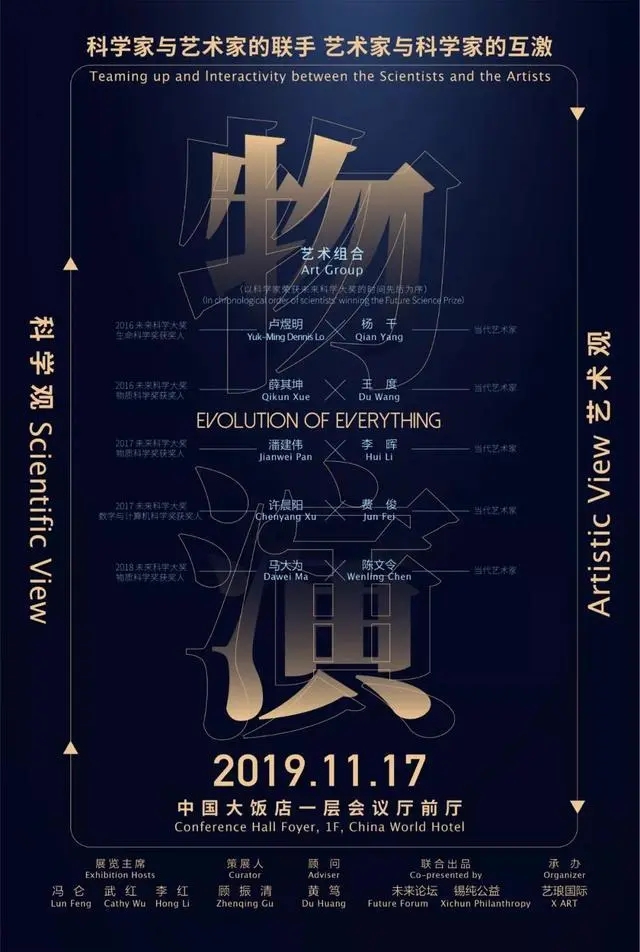
希克
很高兴听到关于这个展览的情况!何谓两年一次?两年一次的意思是“每两年一次”,它没有其他含义。我们要讨论展览,还是每两年开一次的研讨会?我们要讨论艺术家和科学家每两年互相访问一次,还是他们的创作产物?观众是谁呢?所有这些都必须弄清楚,才能提出一个全面的建议。你得多告诉我一点你目前的想法,这样我才能帮上忙。现阶段的问题,是否就是我刚才提到的那些问题?
Uli Sigg: Very encouraging to hear this result of your exhibition! What’s a biennial? Biennial only means “something every two years”and it has no other meaning. Are we talking about an exhibition? Are we talking about a symposium every two years? Are we talking about artists and scientists visiting every two years? Are we talking about a product? Who is the audience? All these things have to be clear to come up with a well-rounded proposal. You have to tell me a little bit more about your current thinking, so that I can be helpful. At this stage, which of the things I just mentioned is it?
顾振清
中国已经有很多双年展了,但这次主题更集中。这个展览的重点是科学和艺术,是一次跨学科的尝试,每一件作品都将由艺术家和科学家联合创作。我们明年将会在北京和上海的美术馆分别举办这次展览,并已经邀请了一些艺术家来为这个展览准备作品。科学家们也非常兴奋,其中有不少对艺术也非常感兴趣,还想创作一些艺术作品,但他们也许对艺术还不是特别了解。如果艺术家和科学家能够走到一起,他们就可以创造一个良好的氛围来进行更深层次的对话和思考,从而清晰地知道如何创造一些东西。虽然这次双年展只是一个展览,但我们正在努力将这种艺术的新方向带入艺术范畴。这次的合作也不仅仅是技术性的合作,而是他们在科学、艺术和创造力的底层逻辑思维上的一种且思且行。
GZQ: There are so many biennales in China already, but this one is more focused. This one is focused on science and art; it’s an interdisciplinary effort. Every work will be produced jointly by artists and scientists. We have proposals for museums in Shanghai and Beijing next year, and we have already invited a few artists to think about that proposal. The scientists are also very excited; many scientists are interested in art, and may have tried to create some artistic work, but they still may not know a lot about art. If artists and scientists can come together, they can create a good atmosphere for deeper conversations and deeper thinking about how to create something. This biennale is just an exhibition, but we are trying to incorporate this new direction into art. The collaborations are not simply technical; they depend on thinking, an underlying logical thinking, about science, about art, about creativity.
乌利·希克
我的问题还不止于此,你已经回答了一部分,你说这是一个展览…
Uli Sigg: My question is rather — you have answered it halfway — you say it’s an exhibition…
顾振清
是的。
GZQ: Yes。
乌利·希克
这是一个展览、一场研讨会还是一次聚会?是每两年推出一次吗?这是一个交流奇思妙想的有趣的创意吗?我的问题是:你想输出什么?据你所讲,似乎希望届时科学家和艺术家之间的合作会有某种实质性的成果,对吧?
US: But is it an exhibition, a symposium, or a get-together? Is the product an exhibition every two years? Is it an interesting protocol for a great exchange of minds? That is my question: What kind of output do you want? From what you said, you seem to expect a physical result of some type to be ready when you launch the biennale, from some cooperation between scientists and artists, right?
顾振清
对。
GZQ: Yes.
乌利·希克
所以你现在必须启动双年展作品创作的进程,并在一年内准备就绪。创作过程是一个艺术家和一个科学家,或者多个艺术家与科学家相互见面开会,并一起头脑风暴、集思广益。然后,艺术家或者科学家去创作一个作品,或者两个人一起工作…这是你的整个想法呢,还是一部分想法?我想知道你现在正在考虑什么。我描述得准确吗?
US: So you will have to launch the process now to be ready in a year, and that process is, say, one artist and one scientist, or many of each side, meet and brainstorm, and then maybe the artist walks away and does a work, or maybe the scientist walks away and does a work, or maybe the two do a work…. Is that the idea, or part of it? I just want to get a better idea of what you’re considering right now. Did I describe it properly?
顾振清
是的,我期待展出的正是作为个体的艺术家和科学家共同创造的产物。作品并不是单单出自艺术家或科学家。他们会合作,一定要在一起讨论并创作作品。这是一种新的思维方式、一种新的策展方式。这对我来说也是一个挑战。在过去几年相关的展览合作中,艺术家确实被他们联合创作的某些作品开启了心智,他们也喜欢参与新的语境,在新的外在情境下创作。他们的思维方式会改变,他们的视野,有时也会因这种新的外在情境而有所变化。
GZQ: Yes, this is a product created by an artist and a scientist, together. The works don’t only come from the artists or the scientists. They’ll collaborate; They have to discuss and produce the work together. This is a new way of thinking and a new style of curating. It’s also a challenge for me.But in the last few years, some of the works that artists have produced have really opened their minds. Artists really like to participate in these new contexts and produce work in new situations. Their way of thinking changes, and sometimes their vision is changed by this new situation.
乌利·希克
那我明白了。我的意思是你必须给这个东西一个框架,但也不要太注重框架。艺术家和科学家如何找到彼此?是你创造了那个机会吗?你又是如何让他们启动创作过程,让他们创作出那个我们称之为艺术作品的东西呢?
US: That’s clear to me. What I mean is that you must give this thing a structure, yet not too much of it. How do the artists and scientists find one another? Do you create that moment, or how do you start the process that will have them produce what I guess we would want to call an artwork?
顾振清
当他们给我提案时,我与策展团队会与艺术家、科学家展开对话。当艺术家和科学家在一个好的项目上达成一致意见时,也许就是一个结尾。有时他们只是做了一些看起来像是合作的东西,有时他们会争吵。科学家们可能会认为有些创作的事情并不是他们的本分,或者不是他们视界中的艺术,这就很困难。当艺术家和科学家真正享受这些创造性对话的时候,他们就可能创作出作品。新的工作可能会无意间超越他们彼此固有的思维方式,因为这与彼此通常的工作有很大的不同,但我们会尽力地给予支持。我们将为好的作品方案支付艺术创作费和材料费,随后艺术家和科学家可以完成作品的创作。
我们可能会展出50%或70%的作品,这是一次实验性的双年展,所以展示方式也具有实验性。我们对艺术的创作过程非常感兴趣,包括他们是如何工作的,以及他们为什么意见不合。我们会为整个创作过程拍摄纪录片,作为展出的艺术品的背景资料。这个双年展既展示艺术家和科学家的作品,同时也展示他们的对话,用以说明创作背景。这有点像科学与艺术实验室——一个可以导引出双年展新模式的实验室。因而,我们尽量给他们一年或更长一些的时间。作为一个独立策展人,这对我是一次前所未有的挑战。
GZQ: When they present me with a proposal, I work with the curatorial team, and we have conversations with the artists and scientists. When the artist and scientist agree on a good project, maybe it ends there. Sometimes they may have something that only looks like a cooperation, and sometimes they may argue. The scientists may think that something is not their job or not their vision of art, so this is difficult. When artists and scientists really enjoy these creative conversations, they may produce new work. Sometimes that new work may transcend their current way of thinking because it’s so different from their formal work, but we try to support them. We will pay an artist fee and a material fee for good proposals, then the artists and scientists can finish, or produce, their work. We might be able to show half or 70% of the project; this is an experimental biennale, so it’s an experimental exhibition. We’re very interested in the production process, including how they were working and why they may have disagreed. We’ll have a lot of documentary footage of the process to give some background on the artworks in the exhibition. We don’t just want to show artworks produced by artists and scientists. We want to show their conversations, and we will make documentaries to give that background. This is a bit like a Science & Art Lab, but this lab could produce a new way of organizing a biennale. We have tried to give them a year, to give them more time, but it’s a good challenge for me, as an independent curator.
乌利·希克
我现在更清晰地了解了这个非常有趣的想法,但我想组织这一进程会有很多的困难,因为它肯定会需要许多资源。结果可能是从想法到最终完成品的任何一种呈现,但我们很难肯定或否定,这种东西究竟是不是艺术作品?或者是科学实验?还是完全别的东西。我理解这一点。
我认为你需要强有力地为创作进程给出一个框架。这样,一年之后,无论结果是什么都能够得以展示。你必须制定一个流程,而且这个流程必须有截止时间。有时两个学科相遇会很麻烦,可能在一种准则下工作已经完成,而在另一种制式中它才刚刚开始。我在人工智能(AI)领域做过一些项目,可以作为你研究其它问题的借鉴,比如:艺术家是否参与其中?如果我们有人工智能,又是否需要艺术家?
我同意你的看法,虽然费时费力,但这是非常有趣并且有前途的。你有足够的资源来完成这一切吗?
US:I see more clearly that it’s a very interesting idea. I see the difficulties of organizing the process, as it will certainly take some resources. The result could be anything from a protocol to a finished work of some kind, and we may or may not be able to call it an artwork, or a scientific experiment, or something else entirely. I understand that.
I think you’ll need a strong hand to give it structure, so that, after one year, there is a result to show, whatever that result is. You have to define a process, and that process has to have an end date. It’s sometimes very difficult when two disciplines meet. One discipline might think that the work is done and the other might think that it is just beginning. I did some projects in the field of artificial intelligence (AI), and that’s where you get into other issues such as: Is an artist involved at all, and do we even need an artist if we have AI?
I agree with you, it’s very promising and interesting, thoughtime-consuming. Do you have the resources to do all of this?
顾振清
是的,我们有足够的资源来很好地完成这个项目。这种工作方式对艺术家也很有帮助。前面也提到,我们还有一个“艺术诊所”的项目。我们邀请了评论家、策展人、科学家、心理学家和文化学者作为我们“艺术诊所”的专家。许多艺术家都非常喜欢这种组合,他们很高兴听到专家们的发言并与他们交谈。我们已经成功地在网上开设了若干艺术家和专家之间的对话。艺术家们真的很喜欢这个项目,因为开阔了他们的视野和思考方式、反思方式。
真正的艺术家在创作中总会面对困难、瓶颈和不确定性,所以他们非常感谢服务器艺术提供这项服务。例如,当艺术家想测试与人工智能有关的艺术作品的应用场景时,我们请来了一位来自人工智能研究协会的专家。这位专家正在做一些中国最前沿的人工智能工作,艺术家们非常喜欢从人工智能专家和他的团队那里得到帮助。
我们还请来了一位萨满教专家,这样艺术家们就可以更好地了解有关萨满教文化,我们还邀请了心理学、认知科学和神经科学等方面的专家分享知识。到目前为止,我们仅有三、四名艺术家参与了“艺术诊所”项目,但效果不错,艺术家们非常关注互动的过程。这不仅仅是关于生产,还涉及到与创作过程的联系。
GZQ: Yes, we have the resources to get good results. This way of working is also very helpful for the artists. As you know, we also have the Art Clinic project. Many artists really like it when we bring in critics, curators, scientists, psychologists, and cultural scholars as experts. The artists are excited to hear them speak and engage in conversation with them. We have already succeeded in setting up a few conversations between artists and experts online. The artists really like this project, because it develops their vision and their ways of thinking and rethinking.
True artists always have to face difficulties, bottlenecks, and uncertainties in their work, so artists really appreciate that the Server Art Foundation offers this service. For example, when artists wanted to test theapplication scenario of their AI artwork, we brought in an expert from the Artificial Intelligence Research Association. This expert is doing some of the most advanced AI work in China, and the artists really enjoyed to receive help from the AI expert and his team.
We also brought in an expert on Shamanism, so the artists could learn more about Shamanistic culture, psychology, cognitive science and neuroscience. We’ve only accepted three or four artists to the Art Clinic project so far, but the results have been good. The artists really preferred to focus on the process of interaction. It’s not just about production; it’s also about connecting to the creative process.
乌利·希克
我认为这个过程有巨大的潜力,这是毋庸置疑的。构建它也是一个很好的学习过程。
US: I think it has great potential. I have no doubt. Structuring it will also be a great learning process.
顾振清
谢谢。我的下一个问题是:目前,网络平台共享知识已经成为一个大趋势。关于在线或虚拟展览、声音作品、虚拟美术馆和线上互动的讨论越来越多。你认为这会改变新冠疫情之后的艺术和收藏吗?您如何看待疫情结束后艺术和艺术收藏的变化?
GZQ: Thank you. My next question is: At present, sharing knowledge through online platforms has become a major trend. There have been more discussions of online or virtual exhibitions, sound works, virtual art galleries, and online interactions. Do you think that this will change art and collecting after COVID-19? After the pandemic is over, how do you see things changing in art and art collections?
乌利·希克
当然,新冠疫情是个变动的指标,而且大多数人设想的前景都相当暗淡。新冠疫情会消失吗?也许不会,也许只在短时间内消失。艺术界空空荡荡的场景真的让我很惊讶。
我刚刚就疫情问题和泰特美术馆开了个会,当然,我也和M+博物馆有过类似的讨论。他们认为他们将不得不与新冠疫情带来的问题斗争多年,有些艺术机构现在已经解雇三分之一甚至更多的员工了。他们认为美国三分之一的博物馆将不会再开门;轰动一时的展览——就像两个月内吸客100万人的莫奈展览,可能再也不会出现了。这将对艺术作品的展览效果和博物馆经营产生巨大影响,但这凸显了拥有收藏的价值,因为有限的资金可能只是用来举办收藏展。这样一来,作品就不必巡回展出了,这就带来另一个气候变化:突然之间,很多人开始思考他们是否应该到世界各地去看展览,艺术作品是否有必要在世界各地展出。也许一个屏幕就可以代替这种巡回模式了。这就回到了你的问题。我个人的看法是,如果有疫苗或其他办法可以赶走新冠病毒,人们将很快回到之前的习惯。但是,如果我们能从疫情后的展示方式中吸取到好的经验,就会知道对于艺术、艺术从业者、艺术市场和艺术收藏来说,老办法也不一定完美无缺。实际上这些虚拟展览馆吸引了很多人,由于疫情,更多的人花了更多的时间来观看艺术品,尽管是在线上。
我们回想一下,人们是如何参观画廊的?北京和上海实属幸运,因为它们有艺术区,所以人们只需花一整天就能看到50个画廊。如果你在伦敦,要看五家画廊是件很辛苦的事,因为它们太分散了。另外,人们在进入画廊时往往会感到有些害羞,因为有人可能正看着你,或想跟你说话。
在辅以高分辨率的虚拟展厅内,有些媒介的作品如照片、视频和平面作品等,更易被观看。三维立体作品或装置作品的展示和观看要困难些,还尚未解决。虚拟展厅,以及所有这些关于广泛主题的网络研讨会,都是应该保留的。事实上,这样一来就接触到了比以前更多的关于艺术和艺术市场的信息,我每天都会收到让我参加一些网络研讨会的电子邮件,无论发言还是只是参与,这种情况在过去还没有过,所以情况已经完全改变了。我认为网络研讨会有趣的方面是:你可以点击进入百万条不同的信息;不利的一面是:我们的注意力和时间会更加分散。我不想一天参加五次网络研讨会,但我可能会每隔一天参加一次。这就是新规则,是的,我认为其中一些规则会继续存在。特别是,我认为用屏幕来代替某些面对面的交流方式肯定会持续下去。
US: Of course, COVID is a moving target, and the prospects most people envision are quite bleak. Will COVID go away? Maybe not, or maybe not for a long time. I’m actually surprised how black the scenarios are in the art world.
I just had a meeting with the Tate on this issue, and of course, I have had similar discussions with M+. They think they’ll have to contend with a COVID-type problem for years, and some have now laid off a third of their people or more. They think a third of all museums in the USA will never open their doors again, because of COVID; they think the time of the blockbuster exhibition—like a Monet show that would draw a million people in two months—may never come back. They think it will have a dramatic effect on the presentation of art and on museums, but this brings out the value of having a collection, because the money may just be there to show collection exhibitions. In this way, the works don’t have to travel, which brings up the other issue of climate change. All of the sudden, a lot of people are wondering if they should be traveling to exhibitions all over the world, and if the works should be traveling to exhibitions all over the world. Maybe a screen could do instead, to come back to your question. Personally, I think that, if there is a vaccine or something, and COVID goes away, people will very much return to old habits. But that doesn’t have to be entirely true for art, for art people, for the art market, and for collecting, if we’ll keep the good from what we’re learning now. All of these virtual exhibition rooms actually draw a lot of people, and more people have spent more time looking at art due to COVID,although on the web.
If we think back, how did people visit galleries? Beijing and Shanghai are actually quite fortunate because they have clusters of galleries, so people can just spend a whole day and see fifty galleries. If you’re in London, it’s very hard work to see five galleries, because they’re so spread out. Also people often feel a bit of shyness about entering galleries, because someone may want to talk to you, and they’re watching you.
The virtual viewing room will remain. Certain mediums can be seen in a viewing room more easily—photographs, videos, and two-dimensional works in general, particularly in high-resolution. What’s more difficult is the three-dimensional works, the installations. That is a problem that has yet to be solved. Viewing rooms, plus all of these webinars on a wide range of topics, will stay. Actually, you have access to a lot more information about art and the art market than before; there’s not a day when I don’t receive emails to join this or that webinar, whether to speak or just to attend. That didn’t happen in the past in the same quantity, so that has completely changed. I think the webinars are an interesting facet, you can click into a million different things. There’s also a downside: there’s more competition for our attention and time. I don’t want to attend five webinars in a day, but maybe I will go to one every other day. These are new rules and, yes, I think some of it will stay. In particular, I think the use of a screen for communication substituting some of the physical presence will definitely persist.
顾振清
好的,我们来讨论最后一个问题,乌利,我不想让你太累。
GZQ: OK, so we’ve come to my last question, Uli. I don’t want to tire you out.
乌利·希克
你真让我进入工作状态了!
US: You’re really making me work here!
顾振清
哈哈,我知道你不仅仅是中国当代艺术的专家,你对西方当代艺术也很有眼光。最后一个问题来自谢蓉:作为未来论坛的艺术顾问,她被委以重任,要建立一个新的美术馆即一个艺术和科学的美术馆,并计划发展一个馆藏项目。你对新成立的美术馆的收藏有什么建议吗?它的藏品是否应该包含更多西方当代艺术?
GZQ: Haha, for my last question: I know that you’re not just an expert in Chinese contemporary art; You also have an eye for Western contemporary art. The last question comes from Xie Rong. As an art consultant for the Future Forum, she was engaged to set up a new museum, an Art and Science Museum. She also plans to develop a collection. Do you have any suggestions for the collection of a new Chinese art museum? Should the collection contain more Western contemporary art?
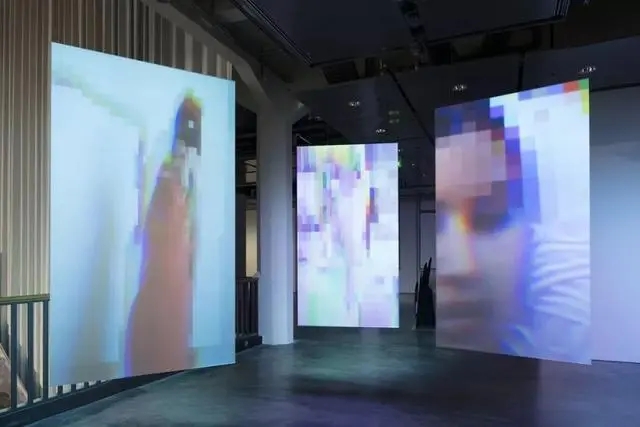
▲ ZKM艺术与媒体中心展览现场, 2019 ZKM
乌利·希克
如果你要创建一个美术馆,我会不遗余力地协助你去创建一个独一无二的馆。这并不容易做到,世界并不凭空需要另一个美术馆。对于一个美术馆来说,艺术和科学已经非常有趣了。你提到了ZKM的例子,在德国它被称之为“数字包豪斯”,据我所知,在中国还没有出现这种类型的美术馆。首先,我认为这是一个非常有趣的想法,但我认为它一定不像其它博物馆,它也不仅仅是一个视觉艺术的美术馆。我最近和一位神经学家聊天,专门从他的观点讨论一个理想的美术馆究竟需要些什么?馆藏也不是一个容易的问题,我只想强调它的异乎寻常,因为这很重要,但我可能还没准备好给出创建一个异乎寻常的美术馆的所有答案。
美术馆要收藏什么?我强烈推荐我的委托创作法。因为这样你就可以瞄准你想要的作品,并且可以确定得到一些完全符合美术馆宗旨的作品。你已经为某些项目选择了艺术家,所以你已经在按照这些思路行动了,但可能与我的委托目的不一样。例如,我会让美术馆只收藏自己委托创作的作品。我会仔细挑选我认为核心的作品,艺术和科学的作品就是属于这一类,然后围绕以上的核心作品进行建构。
不过,你也提到了哲学和人类学,范围很广。事实上,人类学也将是核心,因为这个学科能帮助我们决定如何在这个充满科技奇观的盒子中前进——为了人类自身的生存权利,选择什么、放弃什么。你可能不会马上实现这样一个美术馆,但如果你遵循这个思路,你会建设起一个独一无二的美术馆。至于它收藏中国艺术还是西方艺术,也许就不是那么重要了。它应该只是关于这些特殊的艺术作品,无论它们是由中国还是西方艺术家/科学家组合联合创作的。当然,还有资金问题。你可能会注意到,要买到同一类型的艺术品,在西方或韩国可能比在中国的花费少得多。事实上,用同样的钱,你可以在国外买到更多的艺术品。对于这两种情况下的艺术品收藏方式,我都能坦然接受。
当然,这是一个中国的美术馆,也是在中国创造的一个新理念,我们应该会围绕这个理念来优先考虑中国的艺术和科学。但如果有一个非常有趣的西方作品,或一个完美契合的艺术家,那么我也会收藏这些作品。
我不会限制美术馆的收藏条件,例如藏品必须来自这里或那里等等,但应该围绕着中国艺术家和科学家的合作作为建构收藏的起点。这就是我目前想到的初步答案。
US: If you’re going to establish a museum, I would put a lot of effort into creating a museum like no other - and that’s not easy to do. The world doesn’t need just another museum. I understand though that the focus— art and science—is already very interesting for a museum. You mentioned the case of ZKM, which they call the “Digital Bauhaus” in Germany, and something of that type doesn’t yet, to my knowledge, exist in China. To begin with, I think it’s a very interesting idea, but I think it must be like no other museum, not just one more visual art museum. I recently discussed with a neuroscientist what an ideal museum requires from his point of view.The problem of what to collect also does not have an easy solution. I just want to highlight the idea of being different because it’s important, but I may not have all the answers for how to create a different kind of museum ready yet...
What to collect? I would strongly suggest my method of commissioning, because then you can really target what you want, and you can ascertain to get something that fits exactly into the museum’s mission. You’re already choosing artists for certain projects, so you’re already doing something along those lines, but maybe not yet with the same purpose as my commissions. For instance, I would have the museum only collect what it commissions, and I would carefully select what I feel is the core, art and science in this case, and then build around this core.
However, you also mentioned philosophy and the humanities, so you have a pretty broad range. In fact, the humanities will also be core as far as they help us determine ever more how to steer through this wonderbox of technologies - what to choose and what not, for existential self-interest.You may not have this museum on day one, but you’ll build toward a museum that is unique if you follow that line of thinking. Should it be Chinese art, or should it be Western art? Maybe that becomes less relevant. It should just be about these particular works of art, whether they were made by Chinese artist/scientist combination or a Western author.
Naturally, there is also the question of funding. You may notice that the same type of art may cost you substantially less money in the West or in Korea, than in China. You may in fact get more art for your money elsewhere. I would open myself up to both. Of course, it’s a museum in China and it’s a new idea created here, so why not build this idea around and give preference to Chinese art and science? But if there is a very interesting Western piece, or an artist who fits perfectly, then I would collect them as well. I wouldn’t make it conditional, that it has to be from here or there, but I would build it around Chinese artist and scientist combination to begin. That would be my preliminary answer; that’s simply what comes to my mind.
顾振清
太好了,以上是我所有的问题,乌利。谢谢你的回答。成卓和谢蓉,我们还有几分钟时间,你们还有问题要问吗?
GZQ: Great, that’s all of my questions, Uli. Thank you for your answers. Joy Cheng and Xie Rong, do you have more questions, as we still have a few minutes?
成卓
我能再问一个问题吗?我很想知道你是否希望中国当代艺术进入全球主流?
JC: Can I ask one more? I’m interested to know if you expect Chinese contemporary art to enter the global mainstream.
乌利·希克
是的,我非常希望中国艺术能更多地进入主流,但这并不意味着我希望艺术家们做主流的作品。我所有的努力,比如CCAA中国当代艺术奖、现在的希克奖,其实都是为了让更多的中国艺术家并入这个主流,因为他们值得拥有这些奖。
其实并不是说其他地方的艺术家比中国的艺术家强多少;只是西方这些大型机构,比如卡塞尔文献展和一些国际双年展的掌门人主要是西方人,所以他们把自己知道的东西带进展览。他们不知道的东西可能更好,但不得其门而入。我认为有足够多的中国艺术家有潜力成为主流艺术家,但这需要很多别的连带:它需要有人帮助你到达那个地方,需要有人在正确的时刻看到你,可能需要一个好的画廊给你力量,而不是给别的艺术家。这其中是有很多相关性的,致使在众多有同样潜力的优秀艺术家中,只有一部分人会上升到顶端。他们不一定比其他人好,但幸运的是,所有这些元素在那一刻集合在一起,他们成功了,而其他人没有。我希望,同时也确信,更多的中国艺术家能够加入全球主流。
US: Yes, I very much hope that Chinese art will enter more into the mainstream, but that does not imply that I want the artists to do mainstream work. All of my efforts with, say, the Chinese Contemporary Art Award, now the Sigg Prize, were really about having more Chinese artists come to this mainstream, because they deserve it.
It’s really not that other artists are so much better; it’s just that the gatekeepers to these big institutions, such as DOCUMENTA and the biennales, are predominantly Western people, so they bring in what they know. What they don’t know might be better, but it’s not going to be there. I think there are enough Chinese artists who have the potential to be mainstream artists, but it takes a number of things. It takes someone to help you get there, it takes someone to see you at the right moment, it may take a good gallery that is putting effort into you and not into someone else. It’s a lot of things, and out of a lot of good artists who have the same potential, only some will rise to the top. They are not necessarily better than others, but because of some luck that all these elements fit together in that moment, they make it and others don’t. I hope—and I am certain—that more Chinese artists will be able to join the global mainstream.
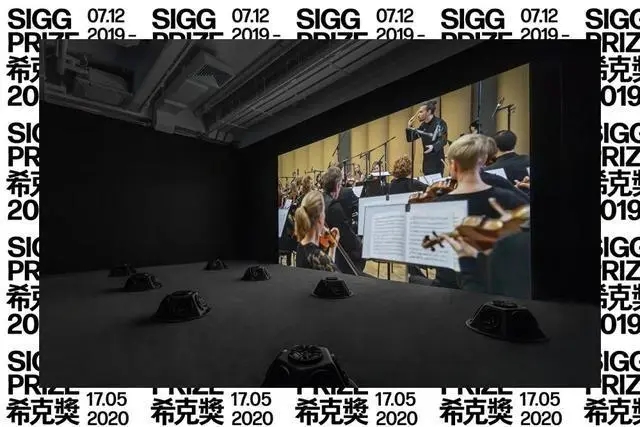
▲ 首届希克奖展览现场照片(2019)
成卓
当你说你的收藏的最终对焦是中国当代艺术时,你是希望中国艺术家为中国社会的变化而做艺术,还是说只要他们是中国艺术家就可以做任何事情?你是否期望中国的艺术家们能扎根于中国的哲学和思想?
JC: When you say the ultimate focus of your collection is Chinese contemporary art, do you want Chinese artists to do work about changes in Chinese society, or can they do anything, as long as they’re Chinese artists? Do you expect Chinese artists to go to their roots, to Chinese philosophy and thinking?
乌利·希克
一点也不,一点也不。在早期回应这个问题时,我曾试图说明白,这只是何种方法的问题。我只想看到一个艺术家非常成功地运用一种方法,无论它是在内容还是在形式上。这个创意可以取自斐济群岛,也可以来自中国传统。但它必须具有新颖性,必须与众不同,它必须表达一种能抓住我们想象力的想法,即我们所期待的艺术品的所有品质。但我对中国特性并没有具体的要求,也许这能对应你提出的问题。它只须是一个来自中国文化空间的艺术家的作品。我正在研究中国的社会和文化,中国文化的空间性将是打开这种特殊研究的好方法。我也能收集一些我的研究成果。不过,我还收藏了其它类型的艺术品。明年4月,我将组织一个关于韩国和朝鲜的展览,我对朝鲜很感兴趣,因为我曾经是瑞士驻朝鲜大使。在这次展览中,除了四位中国艺术家就朝鲜局势进行艺术创作外,其他艺术家都是朝鲜人或韩国人。我有一些其它的收藏,但我真正的热情在于中国艺术收藏。
US: Not at all, not at all. I was trying to say, in my answer to that early question, that this is just one method. I just want to see an artist apply a method very successfully. This can happen in either content or form. The idea can be taken from the Fiji Islands, or it can come from Chinese tradition; it just has to have novelty, it has to be different, and it has to express an idea that captures our imagination—all the qualities we expect in an artwork. But I have no specific Chineseness requirement, maybe that’s what you asked. It just has to be a work of an artist from the Chinese cultural space. I’m researching China its society and culture, and this is just a very good way to do that particular kind of research.I am also able to collect some of the results of my research. However, I also collect other types of art. Next April, in fact, I am organizing an exhibition about South Korea and North Korea, and I have included some Chinese artists who have made artworks about the situation in North Korea. I have an interest in that country, I was ambassador to North Korea as well. In this show, except for four Chinese artists making art about the Korea situation, the artists are all North or South Koreans. I have another collection, but my real real passion is the Chinese collection.
成卓
谢谢,谢谢。
JC: Thank you, thank you.
顾振清
乌利,关于“中国当代艺术”或CCA的概念,我还有一个问题。当人们谈论YBA时,大家都知道指的是“年轻的英国艺术家”。我们知道CCA是什么,这是因为它源自你创立的奖项CCAA,但在全球主流艺术界,大家都懂什么是中国当代艺术吗?
GZQ: Uli, I did have one more question about the concept of “CCA,” or “Chinese contemporary art.” When people talk about the YBAs, everyone knows that means “Young British Artists.” We know what CCA is because of your prize, the CCAA, but in the mainstream global art community, does everyone understand what Chinese contemporary art is?
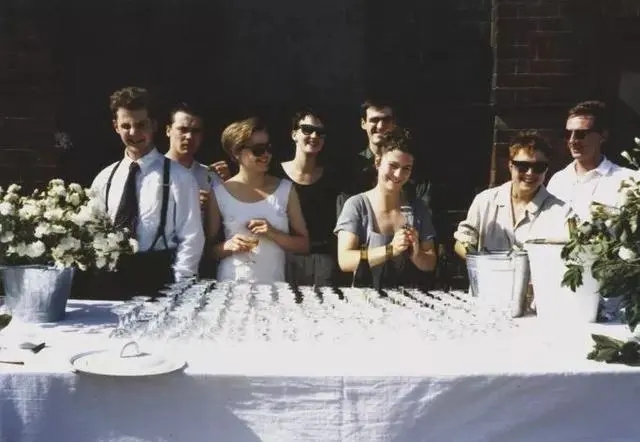
▲ 冻结展开幕式,左起Ian Davenport, Damien Hirst, Angela Bulloch, Fiona Rae, Stephen Park, Anya Gallaccio, Sarah Lucas 和 Gary Hume。该展览“是传说中青年英国艺术家(YBAs)的起源时刻,被视为成就英国现代艺术发展的展览之一。”
希克
这是一个很好的问题,因为关于“什么是中国艺术”、“是否有中国艺术或任何一种民族的艺术”都存在一些争论。但我个人非常确信:有美国艺术,有瑞士艺术,也有中国艺术。为什么我这么确信?让我们以其中一位被认为是真正国际化的艺术家为例。,我喜欢用理查德·普林斯(Richard Prince)的例子,他拍摄的照片多是一些黄昏纵马驰往天际的牛仔,或者骑自行车的女孩。这位艺术家的照片价值数百万美元,但他的作品只来源于美国文化。没有一个中国或瑞士的艺术家会想到为牛仔的骑行配上那种特定的夕阳,或是他作品中那些无数的小细节。这就是我的意思,我们所谓的“全球化”。
但如果我们深入挖掘,假如你是一个想要在我称之为“全球主流”的领域取得成功的当代艺术家,你实际上需要的是与众不同,而不是一成不变。为了不做和理查德·普林斯一样的事情,你必须找到让你别开生面的东西。这种差异最容易在自己的根源中找到。举个例子,如果我是中国人,拥有数千年的文化传承,我所持有的这个特别的传统是一个美国艺术家不会获得的。当然,这并不意味着我们必须最终在作品中加入中国符号。但这可能会反映在对艺术的态度上:比如,在传统山水画中,你由想象而绘画,而不是面对非常现实的风景,你不去再现真实的东西。你可以在传统中发现很多能创造出差异的东西,否则,你就和别人一样了。这就是为什么我认为“中国艺术”这个词是有道理的。
我每每看艺术品的时候,都会不断确认这样的认知——这个艺术家必须生活在一个西方的大城市,那个艺术家必须生活在一个不发达的非洲环境中……艺术折射了很多特定的背景。我能看到这一点,尽管事实上,许多人可能认为作品都是一样的。这些差异尽管是隐藏的,却都最终使艺术变得有趣。的确,“CCAA中国当代艺术奖”的命名是有原因的。不过现在M+博物馆已经接手了这个奖项,他们做的第一件事就是将其命名为“希克奖”。
我觉得“CCAA中国当代艺术奖”是一个更好的名称,它其实是一个伟大的品牌。但他们(M+)认为我的名字也是一个伟大的品牌,所以他们选择了我的名字。当然我感到荣幸……另外,他们明确地扩大了范围,把更多M+的领域和重点包括在内,所以我们把范围扩大到所谓的“大中华区”,大陆,香港,台湾,也许还有新加坡。它意味着中国的文化,我认为谈论中国文化空间是有意义的,因为它和东南亚的文化空间有明显的差异。“大中华区“中艺术的差异性也是确实存在的,但并没有过多受限于地理边界。
US: That’s a good question, because there are some debates about what Chinese art is,whether there is Chinese art - or any national art at that. But I personally am very convinced:that there is American art, there is Swiss art, and there is Chinese art. Why am I so convinced? Let’s just take one of these artists considered really global. I like to use the example of Richard Prince, with the cowboys riding into the evening sky or with these bike girls. This artist’s photos cost millions, but his work can only originate from American culture. No Chinese or Swiss artist would ever think of that cowboy riding paired with that particular sunset, or the million other small details of those works. That’s what I mean. We call it “global,” but if we dig deeper and you are a contemporary artist who wants to be successful in what I call the “global mainstream,” you in factneed to be rather different than the same. To not end up doing the same thing as Richard Prince, I have to find something that makes me different. And this difference is most easily found in my own specific roots. If I’m Chinese, then for instance, I have a very particular tradition I stand on that will not be shared by an American artist. That doesn’t mean that, in the end, we have to have any Chinese symbols in the work, but it may be reflected in the attitude towards art: Say,in the Shanshui tradition, you paint from your imagination, rather than the very realist landscape; you don’t go and represent the real thing. There are lots of things that you can find in your own tradition that can create this difference; otherwise, you’re just like everyone else. That’s why I see a justification for the term Chinese art.
I am confirmed in this every day when I look at art. I see that this artist must live in a big Western city, or this artist must live in an underdeveloped African environment, the art mirrors so much of a specific context. I can see this despite the fact that many people may think the work is all the same. These differences,however hidden, make the art interesting in the end. Yes, there is a reason why I called it “Chinese Contemporary Art Award,” but now the M+ Museum has taken over the prize. The first thing they did was to call it the “Sigg Prize.” I had twenty years to call it the Sigg Prize, but I felt that the Chinese Contemporary Art Award was a much better brand. It’s actually a great brand, but they thought that my name is also a great brand, so they chose my name instead,and of course I feel honored.The other thing was that they explicitly broadened it to encompass more of the M+ territory and focus, so we expanded to what is called “greater China”, Mainland,Hong Kong, Taiwan and maybe Singapore? It implies the Chinese culture, and I think it makes sense to talk about the Chinese cultural space, because that’s very distinct from, say, the Southeast Asian cultural space. There are real differences, but they do not so much follow national borders.
顾振清
好的,谢谢。一个半小时过去了,感谢你与我和我的同事们分享你的经验和学识。
GZQ: OK, thank you. This hour and a half flew by. I want to thank you for sharing your experience and knowledge with us and our colleagues.
谢蓉
乌利,我还有一个问题……您对服务器艺术基金会(筹)有什么期望吗?
XR: Uli, I do have one more question… Do you have a wish for the Server Art Foundation?
乌利·希克
实际上,前段时间你们中有人问我,如果我对这个基金会寄予一个期望的话,能不能想出一句标语,也就是这个期望和标语相关。这个标语是关于创造力的,我认为这是服务器艺术基金会的重点。我谈到创造力是因为我认为这是唯一能拯救我们的东西。当地球被人类毁灭的时候,我们所有的物质资源都会在某个时刻被消耗殆尽。但是有一种资源,即人类的创造力却是无限的。除非我们自己对所有资源都横加干涉,或者像人类目前所做的那样,对于创造力资源无所作为、任其自流。因此,我很高兴服务器艺术基金会专注于创造力,旨在促进中国与国际社会的人类创造力。我想你们就要开始做很有前途的事了。
US:Actually, someone asked me some time ago if I could come up with a slogan, and if I have a wish, it’s related to that. It’s about creativity, which I think is very much the focus of the Server Art Foundation. I have talked about creativity because I think it’s the only thing that can save us. . All of our physical resources will be used up at some point as we destroy the planet, but this one resource, human creativity, has no limitations - unless we impose them by ourselves, or leave it to chance as mankind did up tonow. Therefore I’m very happy that the Server Art Foundation has a focus on creativity and aims to foster creativity in people within and beyond China. I think you have something very promising to start with.
顾振清
谢谢乌利。感谢您与我们分享您的知识和经验。同时也感谢成卓和谢蓉今天的参与。这是一次非常有趣的讨论,我们从中受益匪浅。
GZQ: Thank you, Uli. Thank you for sharing your knowledge and experience with us. Thank you also to Joy Cheng and Xie Rong for participating today. This was a very interesting discussion, and we gained a lot from it.
乌利·希克
谢谢大家。
US: Thank you all.
【声明】以上内容只代表原作者个人观点,不代表artda.cn艺术档案网的立场和价值判断。

